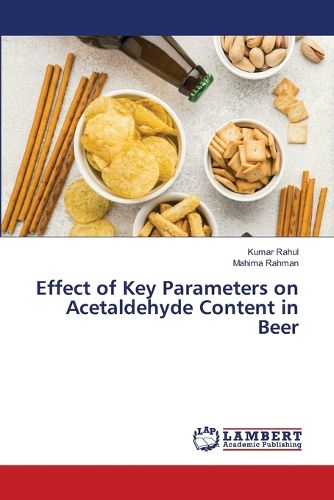Readings Newsletter
Become a Readings Member to make your shopping experience even easier.
Sign in or sign up for free!
You’re not far away from qualifying for FREE standard shipping within Australia
You’ve qualified for FREE standard shipping within Australia
The cart is loading…






Acetaldehyde is a flavorful substance produced during the fermentation of beer by the oxydation of pyruvic acid. When it exceeds the threshold value of 6 ppm, it can cause flavours like green apple or freshly cut grass to become off-putting. The difficulty that the brewing industry is facing is achieving this threshold level within the specified time frame, or 19 days, often known as EOC days (End of Chips) from the time tank full date. It was discovered that this attainment period might last up to 25 days. Multiple brewing process variables have an impact on the acetaldehyde concentration of the EOC. The ultimate purpose of the study is to optimize the brewing process by determining the most important variables and putting methods in place to lower acetaldehyde levels. Acetaldehyde dissipation can be sped up, cutting the entire post-fermentation period in half, from 22 to 19 days. By reducing the occurrence of off tastes, this efficiency improvement can boost production volume while ensuring that the beer fulfils quality standards.
$9.00 standard shipping within Australia
FREE standard shipping within Australia for orders over $100.00
Express & International shipping calculated at checkout
Stock availability can be subject to change without notice. We recommend calling the shop or contacting our online team to check availability of low stock items. Please see our Shopping Online page for more details.
Acetaldehyde is a flavorful substance produced during the fermentation of beer by the oxydation of pyruvic acid. When it exceeds the threshold value of 6 ppm, it can cause flavours like green apple or freshly cut grass to become off-putting. The difficulty that the brewing industry is facing is achieving this threshold level within the specified time frame, or 19 days, often known as EOC days (End of Chips) from the time tank full date. It was discovered that this attainment period might last up to 25 days. Multiple brewing process variables have an impact on the acetaldehyde concentration of the EOC. The ultimate purpose of the study is to optimize the brewing process by determining the most important variables and putting methods in place to lower acetaldehyde levels. Acetaldehyde dissipation can be sped up, cutting the entire post-fermentation period in half, from 22 to 19 days. By reducing the occurrence of off tastes, this efficiency improvement can boost production volume while ensuring that the beer fulfils quality standards.